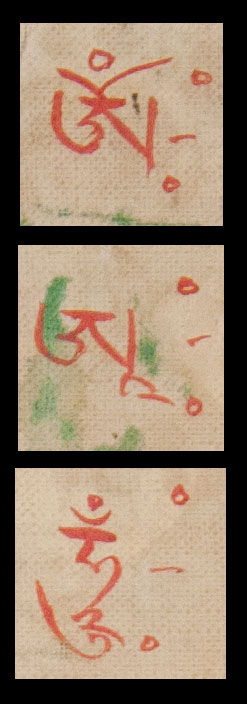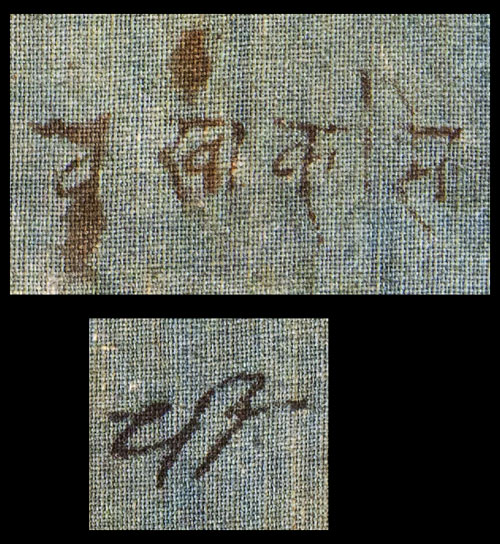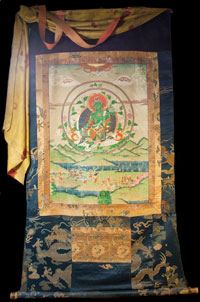mad in pursuit notebook
DISPATCHED FROM THE CROSSROADS
- home >
- favorite themes >
- art & artifacts contents >
- today's entry
Green Tara: Sweet Compassion

I agree with Karen Armstrong that COMPASSION is a the heart of all great religions and spiritual traditions. But of all the modern religions, Buddhism seems to have advanced beyond requiring war to defend its righteousness. The methods for "loving one's enemy" and the mechanics of empathy seem better integrated into daily practice.
These thoughts occur to me as I look at this tangka, this devotional banner from Tibet. The centerpiece is a painting of Green Tara (sGrol ma ljang khu). [Click on photo at the right for a pdf enlargement.]
One source[1] proclaims Tara the most popular goddess in Tibet -- the goddess of universal compassion and the "manifestation of the actions of all buddhas."
Her name is derived from the Sanskrit root word tar (to cross over), meaning one who helps sentient beings to cross over the ocean of existence (samsara) from the impure state to one of perfect, pure enlightenment.
[...] The story of Tara's origin, according to the Tara tantra, recounts that she was born aeons ago in an invisible universe. She was a very spiritual and compassionate woman who gave offerings and prayers to the buddhas, boddhisattvas, and ordained monks, and nuns every day for a thousand billion years. She developed great merit, and the monks told her that, because of her spiritual attainments, they would pray that she be reborn as a man and spread Buddhist teachings. She responded in four verses that there was no male and no female, that nothing existed in reality, but that she wished to remain in female form to serve other beings until everyone reached enlightenment. Thus Tara might be considered the first feminist. [1]
 Of the 21 forms of Tara, Green Tara is the most popular. Her special powers help one cross over from danger to safety, from suffering to happiness. [1]
Of the 21 forms of Tara, Green Tara is the most popular. Her special powers help one cross over from danger to safety, from suffering to happiness. [1]
Green Tara is usually depicted in this seated pose, dressed as a Bodhisattva (one who has achieved Buddhahood, but chooses to return to the world of suffering to save others.) She holds a blue lotus -- symbol for the victory of the spirit over the senses, for intelligence and wisdom, for knowledge. Her hands are in Varada (right, compassion) and Vitarka (left, teaching) mudras. She is surrounded by a 5-color rainbow and is seated on a lotus throne (symbolizing her total purity). [2]
This rendition of Green Tara also depicts a sun (?) and 4 acolytes (?) in the clouds above her. Below is a scene of some sort of miraculous encounter by travelers (Chinese? Mongols?) and their horses. If I'm reading it correctly, they don't fare well. It would appear this group of invaders was repelled by a group of four lamas. Protection from enemies is one of the blessings Tara grants her believers. I'll have to do some more research...
Construction. The painting itself is on cotton canvas, about 17" x 24", predominantly in greens and reds, with rich accents in gold and deep blue. The central icon is surrounded by two thin bands of red-gold silk brocade, representing the mystic rainbow that emanates from the divinity [3]. Interesting: in Tibetan sacred painting, the eyes are last to be drawn in. "Opening the eyes" (spyan-dbye) of the divine figures is an integral part of the consecration ritual [3].
The banner is nearly 50" long, made from strips of silk brocade, decorated with dragons. The "door" of the tangka (the oblong of gold and red brocade beneath the painting) has a geometric floral design. As is typical, a veil of thin gold silk, dotted with splashes of color, is sewn to the top. It protects the painting from dust and smoke and is pulled up during ceremonies. Wooden rods in both top and bottom seams allow the tangka to be rolled up.
On the back are two inscriptions. One is painted directly on the back of the canvas. -- three characters (photos at right). These Sanskrit seed syllables stand for Om Ah Hum, the Tibetan Buddhist chant -- Mantra of Blessing.
At the top of the back, on the blue cotton lining is another set of characters (Sanskrit, I think) and a scribble, in black ink (reproduced below).
Provenance. This tangka was collected in Tibet by C. John Morris (1895-1980) during the First British Himalaya Expedition, in 1922. Morris was a captain a a Gurkha Regiment and served as the expedition's transport officer and assistant photographer. The tangka later passed into the hands of the London antiquarian emporium Kegan Paul, Trench, Trubner & Co. London, where it was sold to my husband in 1970.

---
[1] Treasures of Tibetan Art: Collections of the Jacques Marchais Museum of Tibetan Art by Barbara Lipton and Nima Dorjee Ragnubs, 1996.
[2] Buddhism: Flammarion Iconographic Guides by Louis Frederic, 1995.
[3] Wisdom and Compassion: The Sacred Art of Tibet (Expanded Edition) by Marylin M Rhie and Robert AF Thurman, 1997.
March 15, 2012


